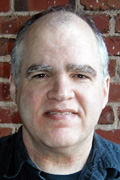Interdisciplinary projects to include Viz, LAND students

Stephen Caffey

Philip Galanter

Bruce Dvorak
Visualization and landscape architecture students will be working with counterparts from numerous other disciplines on groundbreaking projects made possible by a new interdisciplinary initiative at Texas A&M.
Students and faculty will be laying the groundwork for 3-D reconstructions of museum collections, landscapes and entire cities, expanding the possibilities of interactive art through technology research, curating an audiovisual exhibit as well as installing and monitoring a green roof and living wall on campus in projects will be funded by [Tier One Program grants] (http://tamutimes.tamu.edu/2012/02/10/texas-am-announces-tier-one-program-grant-recipients/) , from the [Office of the Dean of Faculties and Associate Provost] (http://dof.tamu.edu/) .
TOP grants, awarded for projects lasting up to three years, help fund interdisciplinary education programs that turn emerging scholarly work, experiential and high impact learning practices into curricular offerings for students at Texas A&M.
“The TOP program is possible due to a budget reallocation, which granted it $1 million in recurring funding,” said Antonio Cepeda-Benito, dean of faculties and associate provost. “That money is going to improve and expand the education experience of undergraduate and post-graduate students. Additionally, the program takes full advantage of the faculty and resources of our Tier One research university status, which gives our students both a competitive edge and a unique experience that couldn’t be provided at other universities.”
Humanities and Visualization Space
Stephen Caffey, assistant professor of architecture, and Philip Galanter, assistant professor of visualization, will help lead a class in which their students will collaborate with communications and English majors on innovative approaches to visualizing literary and musical forms while focusing on ways to deliver visual content for the Humanities and Visualization Space, an immersive, 3-D video wall to be built in the new Arts and Humanities building.
Once the HVS is operational, said Caffey, it will make Texas A&M a destination for scholars exploring technology-based translations and transformations of the humanities.
“One of the most exciting applications will be the ability to recreate exhibitions from different times in history so that students can travel across space and time to see, for example, the Salon of 1824 in Paris or the [1913 Armory Show] (http://xroads.virginia.edu/%7Emuseum/armory/entrance.html) in New York exactly as the works were displayed with all of the paintings and sculpture projected in one-to-one scale,” said Caffey.
Galanter said his students will be participating in design exercises leading to the construction of the 3-D immersive environment, contributing articles to a humanities visualization website that will serve as a research resource, and creating prototypes of visualization tools for the display.
Fresh Minds Festival
Caffey will also be leading students in another TOP-funded project, the Fresh Minds Festival, featuring audiovisual compositions, or visual music, an art form with close ties to generative art and physical computing.
Submissions from an open call for works will be curated by Caffey’s art history students, Galanter’s visualization students and by students pursing related coursework in English and performance studies with direction from their respective professors.
The festival will culminate in a public performance of selected artworks, and up to three artists will be invited to interact with students as artists in residence.
Interactive Arts and Technology Initiative
Visualization students and faculty are also part of the TOP-funded Interactive Arts and Technology Initiative, exploring the creative and imaginative possibilities of interactive art and its application to new technology research.
“A big part of this initiative is the fusion of stage-size or side-of-building-size video projection into dance performances where dancer motion is tracked and used to control computer graphics with an aesthetic goal,” said Galanter.
Students from computer science, engineering and health and kinesiology will also be part of the initiative, integrating learning activities with professional events, local, national and international festivals and conferences, while researching new possibilities of performance capture, interaction, visualization and sound effects.
Galanter said his students will create algorithmically driven computer graphics as well as physical devices that respond to dancer motion.
Green Roof and Green Wall Project
In another TOP-funded initiative, landscape architecture students will join their counterparts in several disciplines [ installing and monitoring] (http://one.arch.tamu.edu/news/2012/4/4/dvorak-greenroof/) a green roof and green wall atop a campus building.
The initiative, said Bruce Dvorak, assistant professor of landscape architecture, is aimed at preparing students to become leaders in energy conservation and resource management.
Green roofs have many benefits, such as reducing the “urban heat island” effect by absorbing light that would otherwise turn into heat energy, absorbing storm water and decreasing runoff, improving air quality and turning an unused space into a potential commercial or recreational space.
“A living wall, said Dvorak, “is a vegetated wall designed to achieve benefits similar to green roofs, but much less is known about its performance.”
Dvorak said the effort will engage up to 1000 students in three colleges from at least seven undergraduate programs, including architecture, construction science, environmental geosciences, environmental studies, landscape architecture, horticulture and meteorology.
Previous post
Next Post
Tags
- academics
- applied creativity
- architecture
- art
- exhibits
- feature
- graduate work
- interdisciplinary
- landscape architecture & urban planning
- research
- rss
- technology
- undergraduate work
- visualization
Related Posts

Texas A&M researchers enabling buildings to ‘breathe’
NSF group melding art, science learning

Posters, addresses earn students 2017 research week honors

Summit explored education advances with ‘smart’ cities
Follow Us
Facebook Twitter Vimeo Youtube Flickr RSS
Recent Posts

Planning prof heads study of disaster housing aid

A message from the dean

Former student remembered as expert planner

Leading educator named new head of Architecture Dept.





_thumbnail_small.png)
